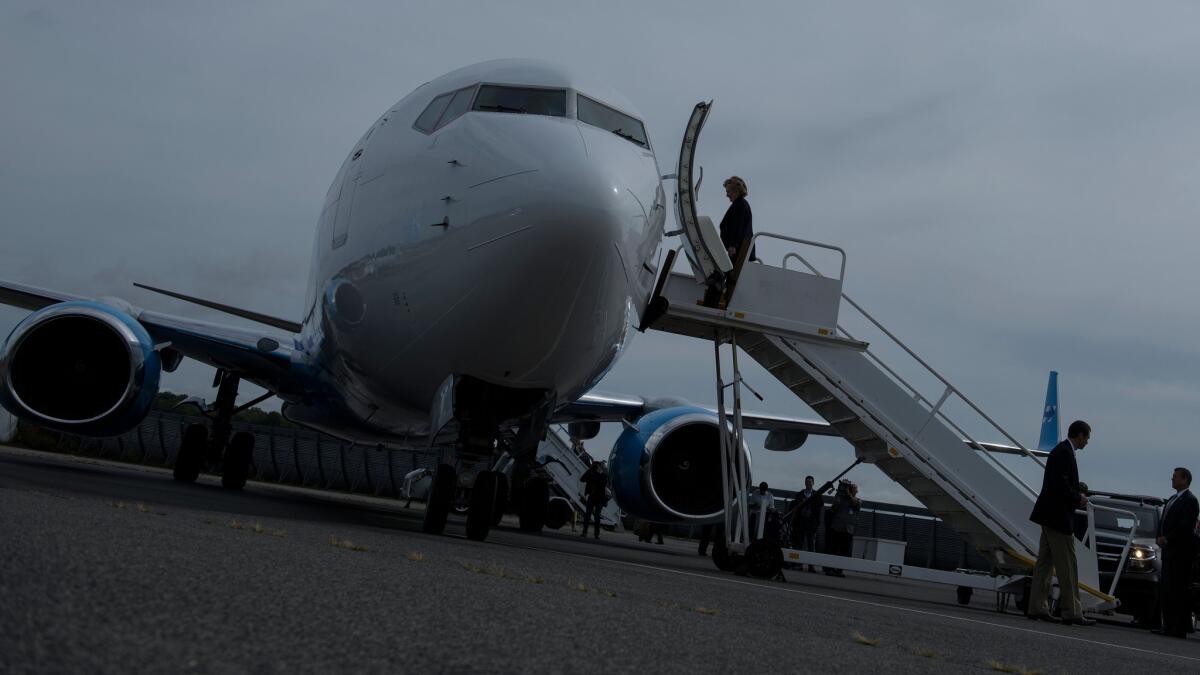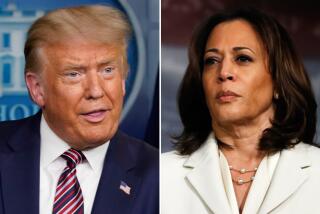Why Trump and Clinton sleep in their own beds most nights even though they’re on the campaign trail

- Share via
Reporting from White Plains, N.Y. — This year’s presidential nominees may have the strangest commutes in American politics.
Almost every morning Hillary Clinton and Donald Trump wake up in their own beds – she in a stately home in suburban Westchester County, N.Y., he in a penthouse atop Trump Tower in Manhattan or occasionally his Mar-a-Lago estate in Florida – and step into a motorcade that whisks them to a nearby airport.
They fly on their campaign planes to whatever battleground state is their target of the day and, after a speech or two and perhaps a fundraiser, they usually return home for the night rather than bunk down in a hotel on the road.
In a year when the news cycle is spinning faster than ever, the candidates themselves seem to be slowing down. Although the new routines may induce head-scratching among some campaign veterans, they’re a reflection of the changing nature of presidential contests, which political professionals say have become less reliant on stump speeches and local media coverage than previous races.
Election 2016 | Live coverage on Trail Guide | Sign up for the newsletter | The race to 270
“There are ways to reach voters outside of campaign events that are targeted and efficient and very effective,” said Hari Sevugan, a spokesman for President Obama’s 2008 campaign who now works as a consultant.
Candidate rallies are good for three things, Sevugan said: collecting voters’ personal information to mobilize them, drawing media attention, and generating energy among supporters. These days, he said, rallies are only truly necessary for the third goal, while candidates can use online videos and social media to organize supporters and spread their message.
Driving local media coverage may not be as important as before either.
Eighty-one percent of U.S. adults get their news online, up from 12% two decades ago, according to the Pew Research Center. Sixty-two percent pull news from social media, while local newspaper readership has declined to 20%.
Clinton’s and Trump’s travel schedules could still get busier over the next month, but their pace is a stark contrast from recent campaigns, when candidates would be hitting multiple states per day and doing frequent interviews with local television stations and newspapers.
Katie Packer, Mitt Romney’s deputy campaign manger in 2012, pointed to a simple reason – both of the candidates are senior citizens. Clinton is 68 and Trump is 70, the oldest pair of nominees ever.
“It speaks to the stamina of both of them,” said Packer, who has led anti-Trump efforts and also opposes Clinton. “My parents like to sleep in their own bed because they’re old. I’m sure Trump and Hillary like to sleep in their own bed because they’re old.”
Romney, who was 65 at this time four years ago, had luxe homes in Massachusetts, New Hampshire, Utah and California but typically eschewed them to overnight in less swanky settings on the road to save time, money and sleep, Packer said.
“He almost always stayed in some Courtyard by Marriott — nothing that even had Egyptian cotton sheets,” she added, jokingly.
Romney held 17 events in the two weeks between the first two presidential debates in 2012, according to the American Presidency Project at UC-Santa Barbara.
In the same time period this year, Clinton held 10 events, plus a few fundraisers and small meetings, while Trump did 19.
The candidates’ travel schedules are also dictated by strategic calculations unique to this election.
A simple early morning tweet from Trump can drive the news for the whole day without fueling up the campaign plane, renting space for a rally and performing in front of television cameras.
“When was the last time you saw a candidate create a 48-hour or 72-hour news cycle with a 140-character tweet?” said Kevin Madden, a Republican who also advised Romney and, like Packer, is not backing Trump. “He didn’t have to spend a lot of campaign resources having an event in a local media market, he didn’t have to move a whole bunch of staff toward an event, he didn’t have to fly [with] the media right beside him.”
Clinton, for her part, is often content to let Trump dominate the news. When a recording emerged of Trump bragging that his celebrity status allows him to grope women, she didn’t hold any events or make any public statements for two days.
“There is a strategic imperative to letting him self-immolate and not getting in the way of that,” said Bill Burton, a Democratic strategist who worked for Obama’s campaign in 2008. “I respect a strategy that lets Donald Trump be Donald Trump.”
She’s also been more willing to burrow into debate preparations than Trump, even if that takes her off the campaign trail for a few days. The third and final debate is Wednesday in Las Vegas.
And she can rely more on a team of popular, high-profile supporters that can draw crowds on their own, including President Obama, Vice President Joe Biden, First Lady Michelle Obama and former President Bill Clinton.
There are geographic reasons the candidates are able to return home almost every night.
“There’s only two swing states west of the Mississippi,” said Democratic pollster Geoff Garin, referring to Colorado and Nevada. Clinton’s campaign has made clear that it views Colorado as solidly in hand, making trips there less necessary. And both already have a built-in stop in Las Vegas, next week for the final debate.
That leaves states like Pennsylvania, Ohio and Florida at the top of the travel itineraries.
“They don’t have to go far out of their comfort zones or their time zones,” Garin said.
That’s a marked change from recent elections, said John Weaver, who advised the presidential campaigns of Sen. John McCain in 2000 and 2008, former Utah Gov. Jon Huntsman in 2012 and Ohio Gov. John Kasich in 2016.
“If you have to be back in Chappaqua or Manhattan every night, it generally limits what you can do scheduling-wise,” Weaver said. “I’m used to working for candidates that will spend four, five, six days in a row on the road … but that’s not what these people do.”
Megerian reported from White Plains and Mehta from Prescott Valley, Ariz.
Twitter: @chrismegerian, @LATSeema
New sex assault allegations against Trump: ‘He was like an octopus’
Trump backers tweet #repealthe19th after polls show he’d win if only men voted
Lots of people have questions about the USC/L.A. Times tracking poll; here are some answers
More to Read
Get the L.A. Times Politics newsletter
Deeply reported insights into legislation, politics and policy from Sacramento, Washington and beyond. In your inbox three times per week.
You may occasionally receive promotional content from the Los Angeles Times.












